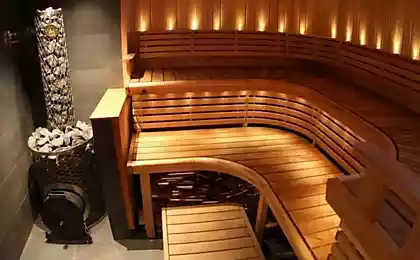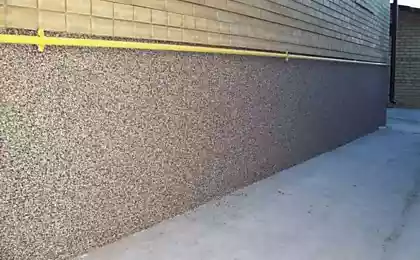838
How to save heat in the house
How to save heat in the house? With the onset of cold weather, this topic becomes very relevant. If you see that expenses and home heating increased, it is time to think about their reasons. Addressing any heat loss will enable you in future to save on heating your home.
Climb into the attic
Check how well insulated the attic floor, because warm air in the first place, seeks it in the attic. For insulation use dry sawdust mixed with lime (1-2 kg per 1 cubic meter of sawdust) layer of 25 cm.
Good insulation are cellulose wadding (cellulose wool). But warming it – it is very dirty, without a respirator and glasses are not enough. The ecowool spread on the floor and straighten machine / whisk on a hand drill.
All the insulation except cellulose fibre, require vapor barriers.

Go underground
The wooden floor of the Foundation can be insulated as well as attic. Vapor barrier is laid immediately under the floor. From drafts from the underground, the ceiling is super-diffused membrane. The cellar should be dry and well ventilated.
Insulation: concrete Foundation indiscriminately flooring enough from the bottom to glue the foam thickness of 10-20 cm Is done on pre-cleaned from dust and primed the concrete with a special glue based on cement.
The foam can be replaced with basalt wool with a minimum density of 80 kg per cubic meter, but it will be more expensive.
Insulated walls
To insulate walls in two ways.
1. The insulation is laid under the curtain wall (siding panels).
2. The insulation is glued to the wall and covered with plaster ("wet facade").
Wall insulation – most expensive item of expenditure: not less than 1500 rubles per square meter.
The question is: what insulation should I choose?
Basalt wool is ideal for insulation of houses of timber. Rarely use foam but may cause condensation. The foam in no case do not use in the insulation of wooden houses, but for insulation of walls from bricks and blocks it is very suitable.
House made of logs insulated with. It is moistened, mixed with glue and using zaduvnaya machine put on the wall. After drying, a warm, tight to the surface "coat". In the same way, you can insulate the wall with the uneven brickwork.
Wool under the hinged facade is covered with windproof membrane. Between her and the facade to leave a ventilated gap of 3-5 cm Foam membrane does not cover – him vanzator not needed.
Keep warm inside the house
Insulate the door and window openings. And even better – insert a new energy-efficient Windows. Make sure that they are properly installed: Windows should be offset in the inner, warm part of the wall. The window opening should be well warmed by a radiator. Good effect gives insulation for exterior soffits.
Glaze the balcony (loggia).
Properly ventilate the area: 2 minute airing every 3-4 hours keeps a lot more heat than static ventilation. Permanently open air vents and Windows to heat the street and increase costs.
Do not close the battery curtains and decorative plates and panels.
Replace cracked or broken glass.
Install heat-reflecting screen for the battery (heat insulation material is laid or plain foil). The room temperature will rise to a degree.
Paint the battery in a dark color and a smooth dark surface emits 5-10% more heat.
In a private home must be insulated, but not heated vestibule.
Build out and glaze the porch on the windward side of the house. Plant trees near the house. They soften the blows of the wind, thereby saving the heat inside the room.
Heat your home! published
P. S. And remember, only by changing their consumption — together we change the world! ©
Join us in Facebook , Vkontakte, Odnoklassniki
Source: vk.com/public65997559?w=wall-65997559_83036
Climb into the attic
Check how well insulated the attic floor, because warm air in the first place, seeks it in the attic. For insulation use dry sawdust mixed with lime (1-2 kg per 1 cubic meter of sawdust) layer of 25 cm.
Good insulation are cellulose wadding (cellulose wool). But warming it – it is very dirty, without a respirator and glasses are not enough. The ecowool spread on the floor and straighten machine / whisk on a hand drill.
All the insulation except cellulose fibre, require vapor barriers.

Go underground
The wooden floor of the Foundation can be insulated as well as attic. Vapor barrier is laid immediately under the floor. From drafts from the underground, the ceiling is super-diffused membrane. The cellar should be dry and well ventilated.
Insulation: concrete Foundation indiscriminately flooring enough from the bottom to glue the foam thickness of 10-20 cm Is done on pre-cleaned from dust and primed the concrete with a special glue based on cement.
The foam can be replaced with basalt wool with a minimum density of 80 kg per cubic meter, but it will be more expensive.
Insulated walls
To insulate walls in two ways.
1. The insulation is laid under the curtain wall (siding panels).
2. The insulation is glued to the wall and covered with plaster ("wet facade").
Wall insulation – most expensive item of expenditure: not less than 1500 rubles per square meter.
The question is: what insulation should I choose?
Basalt wool is ideal for insulation of houses of timber. Rarely use foam but may cause condensation. The foam in no case do not use in the insulation of wooden houses, but for insulation of walls from bricks and blocks it is very suitable.
House made of logs insulated with. It is moistened, mixed with glue and using zaduvnaya machine put on the wall. After drying, a warm, tight to the surface "coat". In the same way, you can insulate the wall with the uneven brickwork.
Wool under the hinged facade is covered with windproof membrane. Between her and the facade to leave a ventilated gap of 3-5 cm Foam membrane does not cover – him vanzator not needed.
Keep warm inside the house
Insulate the door and window openings. And even better – insert a new energy-efficient Windows. Make sure that they are properly installed: Windows should be offset in the inner, warm part of the wall. The window opening should be well warmed by a radiator. Good effect gives insulation for exterior soffits.
Glaze the balcony (loggia).
Properly ventilate the area: 2 minute airing every 3-4 hours keeps a lot more heat than static ventilation. Permanently open air vents and Windows to heat the street and increase costs.
Do not close the battery curtains and decorative plates and panels.
Replace cracked or broken glass.
Install heat-reflecting screen for the battery (heat insulation material is laid or plain foil). The room temperature will rise to a degree.
Paint the battery in a dark color and a smooth dark surface emits 5-10% more heat.
In a private home must be insulated, but not heated vestibule.
Build out and glaze the porch on the windward side of the house. Plant trees near the house. They soften the blows of the wind, thereby saving the heat inside the room.
Heat your home! published
P. S. And remember, only by changing their consumption — together we change the world! ©
Join us in Facebook , Vkontakte, Odnoklassniki
Source: vk.com/public65997559?w=wall-65997559_83036
Rejuvenating face cream with herbs with your hands
Unique tips Siberian herbalist is a need to know!























